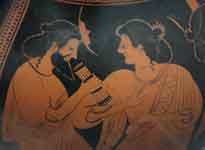.
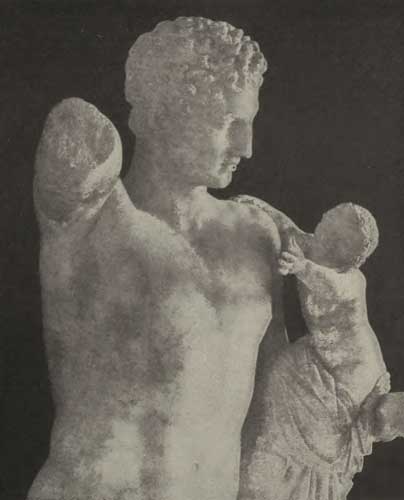
Hermes with the young Dionysus, Praxiteles
Hermēs (Greek: 'Έρμης', Ερμής: 'pile of marker stones'), in Greek mythology, is the god of boundaries and of the travelers who cross them, of shepherds and cowherds, of orators, literature and poets, of athletics, of weights and measures and invention and commerce in general, of the cunning of thieves, and the messenger from the gods to humans. A lucky find was a hermaion. An interpreter who bridges the boundaries with strangers is a hermeneus. Hermes gives us our word "hermeneutics" for the art of interpreting hidden meaning.
Hermes and Dionysus are the youngest of the Olympian pantheon. Son of Zeus and a primordial nymph named Maia, Hermes was born in a cave on Mt. Cyllene in Peloponnesus, between Achaia and Arcadia. His origin on Mt. Cyllene explains the origin of an epithet for Hermēs: Hermēs Cylleneius. He was also referred to as Enagonios.
The Romans found that Hermes was equivalent to their characteristic god Mercury, who may have been the descendent of the Etruscan Turms. The Roman Mercury, with his bulging wallet of the goods of life, later absorbed the Dei Lucrii, early gods of commerce and wealth, and were referred to by that name. In the syncretic religious atmosphere of the Roman Empire, Hermes was combined with the Egyptian Anubis to form Hermanubis. In a similar fashion, the name Hermes Trismegistus was used later by alchemists and their like to refer to a syncretic god combining elements from Hermes and the Egyptian god Thoth.
Hermēs or Mercury was commonly identified by Roman observers with the Germanic god Wotan/Woden/Odin, hence Latin dies Mercurius corresponds to English Wednesday from Wodnes dæg 'Woden's day'.
The modern post office in Greece uses Hermēs as its symbol.
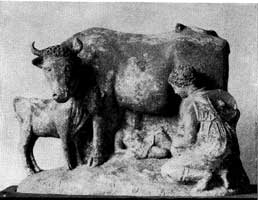
Apollo discovers the young Hermes with his cows
Cult (religion)
Though temples to Hermēs existed throughout Greece, a center of his cult was at Pheneos in Arcadia, where festivals in his honor were called Hermoea.
As a crosser of boundaries, Hermēs Psychopompos' ( ψυχοπομπός ) ("conductor of the soul") was a psychopomp, meaning he brought newly-dead souls to the underworld, Hades. In the Homeric Hymn to Demeter Hermes conducts the Kore safely back to Demeter. He also brought dreams to living mortals.
Hermes as an inventor of fire is a parallel of the titan Prometheus. In addition to the syrinx and the lyre, Hermes invented many types of racing and the sport of boxing. In the 6th century the traditional bearded phallic Hermes was reimagined as an athletic youth (illustration, top right); statues of the new type of Hermēs stood at stadia and gymnasiums throughout Greece.
Hermai
In very ancient Greece, Hermēs was a phallic god of boundaries. His name in the form herma referred to a wayside marker pile of stones; each traveller added a stone to the pile. In the 6th century, Hipparchos, the son of Pisistratus replaced the cairns that marked the midway point between each village deme at the central agora of Athens with a square or rectangular pillar of stone or bronze topped by a bust of Hermēs usually with a beard; an erect phallus rose from the base. In the more primitive "Cyllenian" herms, the standing stone or wooden pillar was frankly simply a phallus. The hermai were used to mark roads and boundaries. In Athens, they were placed outside houses for good luck. "That a monument of this kind could be transformed into an Olympian god is astounding," Walter Burkert remarked (Burkert 1985).
In 415 BC, when the Athenian fleet was about to set sail for Syracuse during the Peloponnesian War, all of the Athenian hermai were vandalized. The Athenians at the time believed it was the work of saboteurs, either from Syracuse or the anti-war faction within Athens itself. Socrates' pupil Alcibiades was suspected to have been involved, and Socrates indirectly paid for the impiety with his life.
Hermes' iconography
Hermēs was usually portrayed wearing a broad-brimmed traveller's hat or a winged cap, wearing winged sandals and carrying his Near Eastern herald's staff, entwined by copulating serpents, called the kerykeion, more familiar in its Latinized form, the caduceus. He wore the garments of a traveler, worker or shepherd. He was represented by purses, roosters (illustration, left) and tortoises.

Hermes the Shepherd from a Relief in Athens
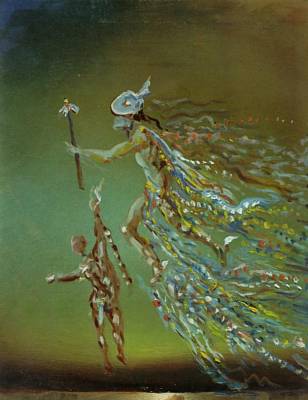
Salvador Dali, Hermes, 1981
Birth
Hermes was born on Mount Cyllene in Arcadia to Maia. As the story is told in the Homeric Hymn, the Hymn to Hermes, Maia was a nymph, but Greeks generally applied the name to an midwife or a wise and gentle old woman, so the nymph appears to have been an ancient one, one of the Pleiades taking refuge in a cave of Arcadia.
The god was precocious: on the day of his birth, by midday he had invented the lyre, using the shell of a tortoise, and by nightfall he had rustled the immortal cattle of Apollo. For the first Olympian sacrifice, the taboos surrounding the sacred kine of Apollo had to be transgressed, and the trickster god of boundaries was the one to do it.
His epithet Argeiphontes (Ἀργειφόντης), or Argus-slayer (ex. Homer Iliad ii 103 and other texts), recalls his slaying of the many-eyed giant Argos who was watching over the heifer-nymph Io in the sanctuary of Lady Hera herself in Argos. Putting Argos to sleep, Hermes dispatched him with a cast stone, like a hero faced by a giant in the land of Canaan.
Hermēs' offspring
Pan
In the Olympic pantheon Pan became the son of Hermēs and the nymph Dryope. She was terrified of her ugly, half-goat baby so she ran away. Hermēs took the baby to Mt. Olympus, where gods enjoyed the child's laughter and good nature. He became a god worshipped by shepherds and woodsmen particularly. Pan was mistakenly reported to have died by a sailor, but, even after this, his shrines and temples were much frequented.
Pan seduced Selene, titan goddess of the moon, one night, while disguised as a white-fleeced sheep. He also pursued the nymph Echo and many other woodland deities, but to little avail.
Abderus
Abderus was a son of Hermes who was devoured by the Mares of Diomedes. He had gone to the Mares with his friend, Herakles.
Hermaphroditus
Hermaphroditus was the third son of Hermēs, with Aphrodite. He was changed into a hermaphrodite by the gods, responding to the pleas of Salmacis, whose love Hermaphroditus spurned.
Priapus
In Priapus, Hermes' phallic origins survived.
Other stories
Herse/Aglaulus/Pandrosus
When Hermēs loved Herse, a jealous Aglaulus stood between them and refused to move. Hermēs changed her to stone. Cephalus was the son of Hermes and Herse. Hermēs also had a son, Ceryx, with Herse's other sister, Pandrosus. With Aglaulus, Hermēs was the father of Eumolpus.
Argus/Io
Zeus loved the Argive princess Io and changed her into a cow to protect her from Hera. Hera suspected his deception and asked for the cow as a present. Zeus was unable to refuse and she placed the watchman Argus to guard the cow. Hermēs, at the request of Zeus, lulled Argus to sleep and rescued Io but Hera sent a gadfly to sting her as she wandered the earth in cow form. Zeus eventually changed her back to human form, and she became—through Epaphus, her son with Zeus—the ancestress of Heracles.
Other roles
Hermēs saved Odysseus from both Calypso and Circe, by convincing the first to let Odysseus go and then protecting him from the latter bestowing upon him an herb that would protect him from Circe's spell. In addition, Hermēs brought Eurydice back to Hades after Orpheus looked back towards his wife for a second time. He also changed the Minyades into bats. He taught the Thriae the arts of fortune-telling and divination.
King Atreus of Mycenae retook the throne from his brother, Thyestes using advice he received from the wise trickster Hermes. Thyestes agreed to give the kingdom back when the sun moved backwards in the sky, a feat that Zeus accomplished. Atreus retook the throne and banished Thyestes.
Consorts/Children
Aphrodite (Eunomia , Hermaphroditus , Peitho , Rhodos , Tyche)
Aglaulus (Eumolpus)
Herse (Cephalus)
Pandrosus (Ceryx )
Dryope (Pan )
Unknown mother (Abderus, Aethalides , Echion, Myrtilus)
Unknown Sicilian nymph (Daphnis)
Links

Hermes Head 430 BC , Roman Copy of a Greek Hermes who sometimes has not only shoes with wings but also wings on his head (or hat)
Hermes and Dionysus of Praxiteles
Cult of Hermes (http://www.theoi.com/Cult/HermesCult.html)
You can find more information, original sources and images at http://www.elolimpo.com/?nombre=hermes&s=per
Reference
Greek Religion, Walter Burkert

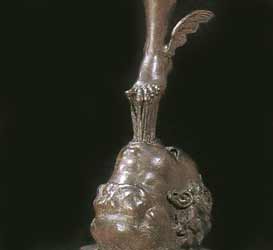
Hermes method of flying (with the help of Zephyrus) 1580, Giambologna (Jean de Boulogne), French/Italian Sculptor, 1529-1608
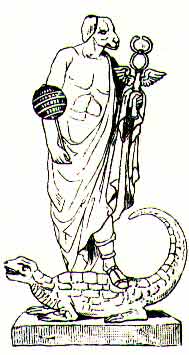
Hellenistic Period: Hermanubis a God produced by the mixture of the Gods Hermes and Anubis. The Greek rulers of Egypt tried to unite the Egyptian and Greek population by inventing new gods. Was the population convinced that Hermanubis is a god?
| Olympians |
| Zeus and Hera |
| Poseidon, Hades, |
| Hestia, Demeter, |
| Aphrodite, Athena, |
| Apollo, Artemis, |
| Ares, Hephaestus, |
| Hermes, Dionysus |
- Gods of the Greeks, Carl Kerenyi
- The Heroes of the Greeks, Carl Kerenyi
- Greek Religion, Walter Burkert
See also : Greek Mythology. Paintings, Drawings
| Ancient Greece
Science, Technology , Medicine , Warfare, , Biographies , Life , Cities/Places/Maps , Arts , Literature , Philosophy ,Olympics, Mythology , History , Images Medieval Greece / Byzantine Empire Science, Technology, Arts, , Warfare , Literature, Biographies, Icons, History Modern Greece Cities, Islands, Regions, Fauna/Flora ,Biographies , History , Warfare, Science/Technology, Literature, Music , Arts , Film/Actors , Sport , Fashion --- |
Retrieved from "http://en.wikipedia.org"
All text is available under the terms of the GNU Free Documentation License

